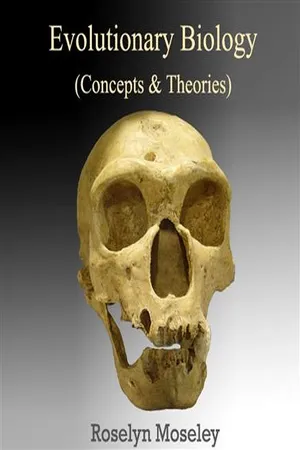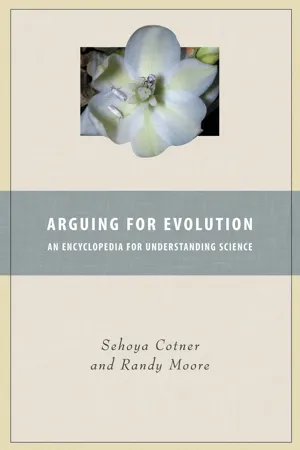Biological Sciences
Common Ancestry
Common ancestry refers to the concept that all living organisms share a common genetic heritage, tracing back to a single ancestral population. This idea is a fundamental principle in evolutionary biology and is supported by evidence from comparative anatomy, genetics, and the fossil record. Understanding common ancestry helps scientists to trace the evolutionary relationships between different species.
Written by Perlego with AI-assistance
Related key terms
1 of 5
4 Key excerpts on "Common Ancestry"
- eBook - ePub
Theistic Evolution
A Scientific, Philosophical, and Theological Critique
- J. P. Moreland, Stephen C. Meyer, Christopher Shaw, Ann K. Gauger, Wayne Grudem, J. P. Moreland, Stephen C. Meyer, Christopher Shaw, Ann K. Gauger, Wayne Grudem(Authors)
- 2017(Publication Date)
- Crossway(Publisher)
1For these reasons, it is appropriate to devote some space to scientifically examining Common Ancestry. Most of the other chapters in this section of the book (Section I, Part 2) will focus on specific claims of human/ape Common Ancestry. This chapter, however, will focus more broadly on universal Common Ancestry—the idea that all living organisms are related.I. Theistic Evolutionists Strongly Endorse Common Ancestry The importance of Common Ancestry to theistic evolution is witnessed in the extremely strong language that theistic evolutionists use when defending the concept.Francis Collins argues in The Language of God that “the conclusion of a common ancestor for humans and mice is virtually inescapable.”2 In Coming to Peace with Science , biologist and former BioLogos president Darrel Falk writes regarding mammals that “virtually all geneticists are convinced . . . they share common ancestors.”3 Another frequent BioLogos author, Dennis Venema, a biologist at Trinity Western University, argues that “[n]um erous independent lines of genomics evidence strongly support the hypothesis that our species shares a common ancestor with other primates.”4 - No longer available |Learn more
- (Author)
- 2014(Publication Date)
- The English Press(Publisher)
________________________ WORLD TECHNOLOGIES ________________________ Chapter- 3 Evidence of Common Descent A large body of evidence of common descent of living things has been discovered by scientists working in a variety of fields over many years. This evidence has demonstrated and verified the occurrence of evolution and provided a wealth of information on the natural processes by which the variety and diversity of life on Earth developed. This evidence supports the modern evolutionary synthesis, the current scientific theory that explains how and why life changes over time. Evolutionary biologists document the fact of common descent: making testable predictions, testing hypotheses and developing theories that illustrate and describe its causes. Comparison of the genetic sequence of organisms has revealed that organisms that are phylogenetically close have a higher degree of sequence similarity than organisms that are phylogenetically distant. Further evidence for common descent comes from genetic detritus such as pseudogenes, regions of DNA that are orthologous to a gene in a related organism, but are no longer active and appear to be undergoing a steady process of degeneration. Fossils are important for estimating when various lineages developed in geologic time. As fossilization is an uncommon occurrence, usually requiring hard body parts and death near a site where sediments are being deposited, the fossil record only provides sparse and intermittent information about the evolution of life. Evidence of organisms prior to the development of hard body parts such as shells, bones and teeth is especially scarce, but exists in the form of ancient microfossils, as well as impressions of various soft-bodied organisms. - No longer available |Learn more
- (Author)
- 2014(Publication Date)
- University Publications(Publisher)
________________________ WORLD TECHNOLOGIES ________________________ Chapter- 2 Evidence of Common Descent A large body of evidence of common descent of living things has been discovered by scientists working in a variety of fields over many years. This evidence has demonstrated and verified the occurrence of evolution and provided a wealth of information on the natural processes by which the variety and diversity of life on Earth developed. This evidence supports the modern evolutionary synthesis, the current scientific theory that explains how and why life changes over time. Evolutionary biologists document the fact of common descent: making testable predictions, testing hypotheses, and developing theories that illustrate and describe its causes. Comparison of the genetic sequence of organisms has revealed that organisms that are phylogenetically close have a higher degree of sequence similarity than organisms that are phylogenetically distant. Further evidence for common descent comes from genetic detritus such as pseudogenes, regions of DNA that are orthologous to a gene in a related organism, but are no longer active and appear to be undergoing a steady process of degeneration. Fossils are important for estimating when various lineages developed in geologic time. As fossilization is an uncommon occurrence, usually requiring hard body parts and death near a site where sediments are being deposited, the fossil record only provides sparse and intermittent information about the evolution of life. Evidence of organisms prior to the development of hard body parts such as shells, bones and teeth is especially scarce, but exists in the form of ancient microfossils, as well as impressions of various soft-bodied organisms. - eBook - PDF
Arguing for Evolution
An Encyclopedia for Understanding Science
- Sehoya H. Cotner, Randy Moore(Authors)
- 2011(Publication Date)
- Greenwood(Publisher)
The geological record and the fossils embedded within (Chapters 2 and 3) tell a convincing story of our evolutionary history. Comparative anatomy (Chapter 6) allows us to appreciate fundamental similarities among, and profound differences between, groups of organisms. Al- though biogeography (Chapter 4) can illuminate the source of a lineage and the pattern of adaptive radiation that followed, molecular biology— in revealing the coding patterns of entire genomes—gives us a histori- cal record like no other. DNA lacks the gaps characteristic of the fossil record, is audible when the rocks are silent, and provides clarity where homology is questionable. In the past few decades, scientists have identi- fied the hereditary material (DNA and RNA), described its structure and operating system, and used this information to establish close relation- ships between some organisms thought to be distant relatives. This new information confirms what was only inferred a few years ago, and en- ables us to test many predictions with respect to the molecular evidence for evolution. Common Ancestry Is Revealed by a Common Hereditary Material (DNA or RNA) The ultimate universal homologies—that is, features shared by all liv- ing organisms—are our cellular architecture (all living things are made of cells), our use of ATP to do work at the cellular level, and the genetic code. These features lend unequivocal support for Common Ancestry. Moreover, the genetic code provides additional details about key events in evolution (e.g., the origin of photosynthesis, advent of multicellularity, transition to land, and development of bipedality). Related Organisms Reveal Their Genetic Similarity through Protein Similarity Antigen Specificity Early attempts to determine evolutionary relationships using molecular techniques focused on antigen specificity.
Index pages curate the most relevant extracts from our library of academic textbooks. They’ve been created using an in-house natural language model (NLM), each adding context and meaning to key research topics.



